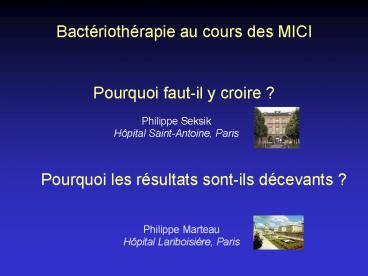Bact - PowerPoint PPT Presentation
1 / 37
Title: Bact
1
Bactériothérapie au cours des MICI
Pourquoi faut-il y croire ?
Philippe Seksik Hôpital Saint-Antoine, Paris
Pourquoi les résultats sont-ils décevants ?
Philippe Marteau Hôpital Lariboisière, Paris
2
OBJECTIVES
Is intestinal microbiota a target in IBD ? Can
gut inflammation be modulated by probiotics ?
YES YES
3
70 of bacterial species remain not cultivable
cultivated fraction cultivated fraction
Tannock 2000 21-37
Suau 1999 21-32
? Needs culture independent technics
4
16S rRNA
16S rARN
21 proteins
small sub-unit
Bacteria
70S Ribosome
- ubiquitous molecules
- primary mosaic structure
- highly conserved regions (Domains)
- variable regions (phylogenetic Groups)
- hypervariable regions (bacterial species
or OTU Operational
Taxonomic Unit) - new classification phylogenetic
- gt200000 sequences of 16S genes
5
Birth gut is sterile acquisition of an
adult microbiota (2 years)
Environment Host Factors
Bacterial Species Colonization
Biodiversity Stability Functions (protection)
6
Biodiversity
7
Distribution of bacterial species along the
digestive tract
Stomach
Streptococcus
Small bowell
(ileum)
Lactobacillus
Streptococcus
coli
E.
Clostridium
Bacteroides
Eubacterium
Veillonella
1014 bacteria (gut) 1013 cells (human
being) microbial census exceeds the total body
number of our own human cells by 10 fold
8
healthy controls
88 OTU
OTU (Operational Taxonomic Unit) sequences with
similarity 98
Manichanh et al.Gut. 2006
9
healthy controls
CD
54 OTU
88 OTU
OTU (Operational Taxonomic Unit) sequences with
similarity 98
Manichanh et al.Gut. 2006
10
Stability
11
Dominant faecal microbiota in humans (TTGE
profiles - 16S rDNA)
- fingerprint
- Inter individual variability
12
Instability of fecal microbiota in CD
100
90
80
70
60
50
R1
R2
A active disease R remission
A4
R3
A2
A3
A1
R4
Seksik P et al. Gut. 2003
100
90
80
70
60
STABILITY
50
40
30
20
10
0
CD in remission
Controls
CD Flare-up
Scanlan et al. JCM 2006
13
Functions
14
Barrier effect
Space occupation Competitive exclusion Antimicrobi
al peptides
BACTERIOCINES DEFENSINES ?-defensins
HD-5,6 ileum (paneth cells) ?-
defensins HBD1 -4 colon
(enterocytes) Cathedecidins Wehkamp Cur Opin
G 2006 Reg III? lectin HIP/PAP (enterocytes) Hoope
r Science 2006
15
Functions
CAMP Commensal associated molecular patterns
Flagellin
LPS
PG (MDP, DAP)
CpG DNA
PRR Pattern Recognition Receptors membrane
bound ? TLR Toll-like receptor intra-cellular
PRR ? NOD nucleotid oligodimerization domain
16
Innate Immunity
intra-cellular transduction signal pathways
Bonen DK, Cho JH. Gastroenterology. 2003
17
(No Transcript)
18
Innate immunity in CD and impaired mucosal
defense
- CARD15/NOD2 mutations in CD RR 20 to 40
- Mutation CARD15/NOD2
- ? decrease in ?-defensins
- decrease in inductible ?-defensins (HBD2)
Wehkamp PNAS 2005 Voss JBC 2006
19
in IBD ? high bacterial loads in the mucus
Concentrations of mucosa associated Bact.
Numbers of Bact. per total surface length
Schultsz et al. Gastroenterology 1999
Swidsinki et al. Gastroenterology 2002
20
Dysbiosis
Crohn
Infectious colitis
120
UC
Healthy subjects
100
80
60
40
20
0
Additivity
Sokol et al. IBD 2006
21
summary
Healthy IBD
Biodiversity restriction
Stability restriction
Innate Immunity N Mutations NOD2 TLR4 polymorphism
Defensins N decrease
Bacterial load N
Dysbiosis -
Microbiota therapeutic target
22
Probiotics
23
Bacteria what are they able to do ?
Dendritic cell
IgA
cytokines
T Lymphocytes
B Lymphocytes
Th1
Th2
Treg
24
Bacteria what are they able to do ?
To restore biodiversity normobiosis
Dendritic cell
IgA
cytokines
T Lymphocytes
B Lymphocytes
Th1
Th2
Treg
25
Bacteria what are they able to do ?
To reinforce gut barrier
Dendritic cell
IgA
cytokines
T Lymphocytes
B Lymphocytes
Th1
Th2
Treg
26
Bacteria what are they able to do ?
To inhibit pro-inflammatory cytokines
Dendritic cell
IgA
cytokines
T Lymphocytes
B Lymphocytes
Th1
Th2
Treg
27
To restore biodiversity and normobiosis
Dendritic cell
IgA
cytokines
T Lymphocytes
B Lymphocytes
Th1
Th2
Treg
28
Some probiotics are capable of inhibiting
bacterial adhesion and invasion of E. coli LF82
strain
L. casei DN-114 001
E. coli Nissle 1917
LF82 invasion
Ingrassia et al. AEM 2005
Boudeau et al. APT 2003
29
L. salivarius UCC118
109 UCC118 /mL
Mice KO IL-10
? Coliforms ? Enterococcus ? Bifidobacterium,
Bacteroides, Lactobacillus
OMahony et al. APT 2001 McCarthy et al. GUT 2003
30
VSL3 can restore mucosa-associated bacterial
biodiversity in pouchitis
Kuhbacher, T et al. Gut 2006
31
To reinforce the gut barrier
Dendritic cell
IgA
cytokines
T Lymphocytes
B Lymphocytes
Th1
Th2
Treg
32
E. coli Nissle 1917
DEFENSINS
Tight Junctions
EcN induces the expression of HB D-2 activation
of the hBD-2 promoter AP-1
and NFkB pathways
Increased expression of ZO-2 and PK C
Zirrek et al. Cell microbiol 2006
Wehkamp et al. Infect immun 2004
33
To influence adaptative immune response
Dendritic cell
IgA
cytokines
T Lymphocytes
B Lymphocytes
Th1
Th2
Treg
34
L. salivarius UCC118 Bifidobacterium infantis
35624 attenuate colitis in KO IL-10 mice model
McCarthy et al. GUT 2003
35
VSL3 influences immune response
VSL3
Dendritic cell
T Lymphocytes
Th1
Th2
Treg
Hart et al. GUT 2004
36
Conclusion
Microbiota
Modulation of microbiota using probiotics to
control or prevent gut inflammation is
LOGICAL
ECO
37
Bactériothérapie au cours des MICI
Pourquoi faut-il y croire ?
Philippe Seksik Hôpital Saint-Antoine, Paris
Pourquoi les résultats sont-ils décevants ?
Philippe Marteau Hôpital Lariboisière, Paris































